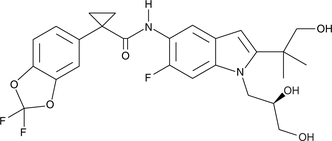Chemicals
Showing 39901–40050 of 41137 results
-
Vulpinic acid is a lichen metabolite that has been found in L. vulpina and has diverse biological activities.{50292,50293,50294,50295} It is active against C. perfringens, B. vulgatus, B. fragilis, B. loescheii, P. acnes, E. faecium, and methicillin-susceptible and -resistant S. aureus (MICs = 4-16 μg/ml).{50292} Vulpinic acid (25-800 μM) prevents UVB-induced apoptosis, cytotoxicity, and cytoskeletal modifications in HaCaT human keratinocytes.{50293} It also increases scratch wound healing of HaCaT cells.{50294} Vulpinic acid (15 μM) reduces hydrogen peroxide-induced production of reactive oxygen species (ROS) and cytotoxicity in human umbilical vein endothelial cells (HUVECs).{50295}
Brand:CaymanSKU:21685 -Out of stock
Vulpinic acid is a lichen metabolite that has been found in L. vulpina and has diverse biological activities.{50292,50293,50294,50295} It is active against C. perfringens, B. vulgatus, B. fragilis, B. loescheii, P. acnes, E. faecium, and methicillin-susceptible and -resistant S. aureus (MICs = 4-16 μg/ml).{50292} Vulpinic acid (25-800 μM) prevents UVB-induced apoptosis, cytotoxicity, and cytoskeletal modifications in HaCaT human keratinocytes.{50293} It also increases scratch wound healing of HaCaT cells.{50294} Vulpinic acid (15 μM) reduces hydrogen peroxide-induced production of reactive oxygen species (ROS) and cytotoxicity in human umbilical vein endothelial cells (HUVECs).{50295}
Brand:CaymanSKU:21685 -Out of stock
Vulpinic acid is a lichen metabolite that has been found in L. vulpina and has diverse biological activities.{50292,50293,50294,50295} It is active against C. perfringens, B. vulgatus, B. fragilis, B. loescheii, P. acnes, E. faecium, and methicillin-susceptible and -resistant S. aureus (MICs = 4-16 μg/ml).{50292} Vulpinic acid (25-800 μM) prevents UVB-induced apoptosis, cytotoxicity, and cytoskeletal modifications in HaCaT human keratinocytes.{50293} It also increases scratch wound healing of HaCaT cells.{50294} Vulpinic acid (15 μM) reduces hydrogen peroxide-induced production of reactive oxygen species (ROS) and cytotoxicity in human umbilical vein endothelial cells (HUVECs).{50295}
Brand:CaymanSKU:21685 -Out of stock
VX-509 is a selective inhibitor of Janus kinase 3 (JAK3) with a Ki value of 2.5 nM in enzyme assays and an IC50 value of 50-170 nM in cellular assays dependent on JAK3 activity with no measurable activity against other JAK isotypes.{31666} At 10-100 mg/kg, it has been shown to dose dependently reduce proinflammatory responses in a rat collagen-induced arthritis model and a mouse model of oxazolone-induced delayed-type hypersensitivity.{31666}
Brand:CaymanSKU:-Available on backorder
VX-509 is a selective inhibitor of Janus kinase 3 (JAK3) with a Ki value of 2.5 nM in enzyme assays and an IC50 value of 50-170 nM in cellular assays dependent on JAK3 activity with no measurable activity against other JAK isotypes.{31666} At 10-100 mg/kg, it has been shown to dose dependently reduce proinflammatory responses in a rat collagen-induced arthritis model and a mouse model of oxazolone-induced delayed-type hypersensitivity.{31666}
Brand:CaymanSKU:-Available on backorder
VX-509 is a selective inhibitor of Janus kinase 3 (JAK3) with a Ki value of 2.5 nM in enzyme assays and an IC50 value of 50-170 nM in cellular assays dependent on JAK3 activity with no measurable activity against other JAK isotypes.{31666} At 10-100 mg/kg, it has been shown to dose dependently reduce proinflammatory responses in a rat collagen-induced arthritis model and a mouse model of oxazolone-induced delayed-type hypersensitivity.{31666}
Brand:CaymanSKU:-Available on backorder
VX-509 is a selective inhibitor of Janus kinase 3 (JAK3) with a Ki value of 2.5 nM in enzyme assays and an IC50 value of 50-170 nM in cellular assays dependent on JAK3 activity with no measurable activity against other JAK isotypes.{31666} At 10-100 mg/kg, it has been shown to dose dependently reduce proinflammatory responses in a rat collagen-induced arthritis model and a mouse model of oxazolone-induced delayed-type hypersensitivity.{31666}
Brand:CaymanSKU:-Available on backorder
VX-661 is an investigational compound that promotes the maturation of delta F508 mutants of the cystic fibrosis transmembrane conductance regulator (CFTR).{34006} Delta F508 CFTR represents a class of CFTR mutation that is characterized by impaired processing of misfolded CFTR proteins and reduced accumulation of the protein at the cell surface.{34006} VX-661 is intended to facilitate trafficking of CFTR to the epithelial cell membrane. It may be combined with the CFTR potentiator ivacaftor (Item No. 15145) to stimulate both CFTR accumulation and opening at the apical epithelial surface.{34006,34007}
Brand:CaymanSKU:21480 -Out of stock
VX-661 is an investigational compound that promotes the maturation of delta F508 mutants of the cystic fibrosis transmembrane conductance regulator (CFTR).{34006} Delta F508 CFTR represents a class of CFTR mutation that is characterized by impaired processing of misfolded CFTR proteins and reduced accumulation of the protein at the cell surface.{34006} VX-661 is intended to facilitate trafficking of CFTR to the epithelial cell membrane. It may be combined with the CFTR potentiator ivacaftor (Item No. 15145) to stimulate both CFTR accumulation and opening at the apical epithelial surface.{34006,34007}
Brand:CaymanSKU:21480 -Out of stock
VX-661 is an investigational compound that promotes the maturation of delta F508 mutants of the cystic fibrosis transmembrane conductance regulator (CFTR).{34006} Delta F508 CFTR represents a class of CFTR mutation that is characterized by impaired processing of misfolded CFTR proteins and reduced accumulation of the protein at the cell surface.{34006} VX-661 is intended to facilitate trafficking of CFTR to the epithelial cell membrane. It may be combined with the CFTR potentiator ivacaftor (Item No. 15145) to stimulate both CFTR accumulation and opening at the apical epithelial surface.{34006,34007}
Brand:CaymanSKU:21480 -Out of stock
VX-661 is an investigational compound that promotes the maturation of delta F508 mutants of the cystic fibrosis transmembrane conductance regulator (CFTR).{34006} Delta F508 CFTR represents a class of CFTR mutation that is characterized by impaired processing of misfolded CFTR proteins and reduced accumulation of the protein at the cell surface.{34006} VX-661 is intended to facilitate trafficking of CFTR to the epithelial cell membrane. It may be combined with the CFTR potentiator ivacaftor (Item No. 15145) to stimulate both CFTR accumulation and opening at the apical epithelial surface.{34006,34007}
Brand:CaymanSKU:21480 -Out of stock
VX-702 is a third generation inhibitor of p38 mitogen-activated protein (MAP) kinases, binding to both p38α and p38β (Kd = 3.7 and 17 nM, respectively) in an ATP-competitive fashion.{21533} It inhibits IL-6, IL-1β, and TNF-α production in LPS-primed blood with IC50 values of 59, 122, and 99 ng/ml, respectively.{21533} VX-702, at 1 μM, inhibits activation of p38 in platelets by thrombin, U-46619 (Item No. 16450), or collagen but does not block platelet aggregation in response to collagen.{21534} Although orally active, VX-702 provides only transient suppression of biomarkers of inflammation in ongoing rheumatoid arthritis.{21532}
Brand:CaymanSKU:-VX-702 is a third generation inhibitor of p38 mitogen-activated protein (MAP) kinases, binding to both p38α and p38β (Kd = 3.7 and 17 nM, respectively) in an ATP-competitive fashion.{21533} It inhibits IL-6, IL-1β, and TNF-α production in LPS-primed blood with IC50 values of 59, 122, and 99 ng/ml, respectively.{21533} VX-702, at 1 μM, inhibits activation of p38 in platelets by thrombin, U-46619 (Item No. 16450), or collagen but does not block platelet aggregation in response to collagen.{21534} Although orally active, VX-702 provides only transient suppression of biomarkers of inflammation in ongoing rheumatoid arthritis.{21532}
Brand:CaymanSKU:-VX-702 is a third generation inhibitor of p38 mitogen-activated protein (MAP) kinases, binding to both p38α and p38β (Kd = 3.7 and 17 nM, respectively) in an ATP-competitive fashion.{21533} It inhibits IL-6, IL-1β, and TNF-α production in LPS-primed blood with IC50 values of 59, 122, and 99 ng/ml, respectively.{21533} VX-702, at 1 μM, inhibits activation of p38 in platelets by thrombin, U-46619 (Item No. 16450), or collagen but does not block platelet aggregation in response to collagen.{21534} Although orally active, VX-702 provides only transient suppression of biomarkers of inflammation in ongoing rheumatoid arthritis.{21532}
Brand:CaymanSKU:-p38α is a member of the mitogen-activated protein kinase (MAPK) family of serine/threonine protein kinases. It is widely expressed in endothelial, immune, and inflammatory cells and plays a central role in the regulation of proinflammatory cytokine production including TNF-α, IL-1β, and IL-6. VX-745 is a potent inhibitor of p38α MAPK (IC50 = 10 nM) with 20-fold selectivity over p38β and 1000-fold selectivity over closely related kinases, ERK1 and JNK1-3.{29195} It blocks IL-1β and TNF-α release in whole blood in vitro with IC50 values of 150 and 180 nM, respectively.{29195} VX-745 has been shown to demonstrate anti-inflammatory efficacy in an animal model of rheumatoid arthritis, but was discontinued in clinical trial due to adverse central nervous system effects.{21533}
Brand:CaymanSKU:-Available on backorder
p38α is a member of the mitogen-activated protein kinase (MAPK) family of serine/threonine protein kinases. It is widely expressed in endothelial, immune, and inflammatory cells and plays a central role in the regulation of proinflammatory cytokine production including TNF-α, IL-1β, and IL-6. VX-745 is a potent inhibitor of p38α MAPK (IC50 = 10 nM) with 20-fold selectivity over p38β and 1000-fold selectivity over closely related kinases, ERK1 and JNK1-3.{29195} It blocks IL-1β and TNF-α release in whole blood in vitro with IC50 values of 150 and 180 nM, respectively.{29195} VX-745 has been shown to demonstrate anti-inflammatory efficacy in an animal model of rheumatoid arthritis, but was discontinued in clinical trial due to adverse central nervous system effects.{21533}
Brand:CaymanSKU:-Available on backorder
p38α is a member of the mitogen-activated protein kinase (MAPK) family of serine/threonine protein kinases. It is widely expressed in endothelial, immune, and inflammatory cells and plays a central role in the regulation of proinflammatory cytokine production including TNF-α, IL-1β, and IL-6. VX-745 is a potent inhibitor of p38α MAPK (IC50 = 10 nM) with 20-fold selectivity over p38β and 1000-fold selectivity over closely related kinases, ERK1 and JNK1-3.{29195} It blocks IL-1β and TNF-α release in whole blood in vitro with IC50 values of 150 and 180 nM, respectively.{29195} VX-745 has been shown to demonstrate anti-inflammatory efficacy in an animal model of rheumatoid arthritis, but was discontinued in clinical trial due to adverse central nervous system effects.{21533}
Brand:CaymanSKU:-Available on backorder
p38α is a member of the mitogen-activated protein kinase (MAPK) family of serine/threonine protein kinases. It is widely expressed in endothelial, immune, and inflammatory cells and plays a central role in the regulation of proinflammatory cytokine production including TNF-α, IL-1β, and IL-6. VX-745 is a potent inhibitor of p38α MAPK (IC50 = 10 nM) with 20-fold selectivity over p38β and 1000-fold selectivity over closely related kinases, ERK1 and JNK1-3.{29195} It blocks IL-1β and TNF-α release in whole blood in vitro with IC50 values of 150 and 180 nM, respectively.{29195} VX-745 has been shown to demonstrate anti-inflammatory efficacy in an animal model of rheumatoid arthritis, but was discontinued in clinical trial due to adverse central nervous system effects.{21533}
Brand:CaymanSKU:-Available on backorder
VX-765 is a prodrug form of the caspase-1 inhibitor VRT-043198.{45582} VX-765 (50, 100, and 200 mg/kg) inhibits LPS-induced increases in serum IL-1β levels in mice. It also reduces oxazolone-induced ear edema and levels of IL-1β, IL-18, and IFN-γ in ear tissue in an oxazolone-sensitized mouse model of delayed-type hypersensitivity. VX-765 reduces forepaw inflammation in a mouse model of collagen-induced arthritis in a dose-dependent manner. VX-765 (≥50 mg/kg) decreases seizure duration and the number of seizures in a mouse model of acute seizures induced by hippocampal kainic acid injection, as well as delays the onset of seizures when administered at doses of 100 and 200 mg/kg.{45583} It also reduces the aggregated duration of epileptic activity in a mouse model of chronic epilepsy.
Brand:CaymanSKU:28825 - 10 mgAvailable on backorder
VX-765 is a prodrug form of the caspase-1 inhibitor VRT-043198.{45582} VX-765 (50, 100, and 200 mg/kg) inhibits LPS-induced increases in serum IL-1β levels in mice. It also reduces oxazolone-induced ear edema and levels of IL-1β, IL-18, and IFN-γ in ear tissue in an oxazolone-sensitized mouse model of delayed-type hypersensitivity. VX-765 reduces forepaw inflammation in a mouse model of collagen-induced arthritis in a dose-dependent manner. VX-765 (≥50 mg/kg) decreases seizure duration and the number of seizures in a mouse model of acute seizures induced by hippocampal kainic acid injection, as well as delays the onset of seizures when administered at doses of 100 and 200 mg/kg.{45583} It also reduces the aggregated duration of epileptic activity in a mouse model of chronic epilepsy.
Brand:CaymanSKU:28825 - 25 mgAvailable on backorder
VX-765 is a prodrug form of the caspase-1 inhibitor VRT-043198.{45582} VX-765 (50, 100, and 200 mg/kg) inhibits LPS-induced increases in serum IL-1β levels in mice. It also reduces oxazolone-induced ear edema and levels of IL-1β, IL-18, and IFN-γ in ear tissue in an oxazolone-sensitized mouse model of delayed-type hypersensitivity. VX-765 reduces forepaw inflammation in a mouse model of collagen-induced arthritis in a dose-dependent manner. VX-765 (≥50 mg/kg) decreases seizure duration and the number of seizures in a mouse model of acute seizures induced by hippocampal kainic acid injection, as well as delays the onset of seizures when administered at doses of 100 and 200 mg/kg.{45583} It also reduces the aggregated duration of epileptic activity in a mouse model of chronic epilepsy.
Brand:CaymanSKU:28825 - 5 mgAvailable on backorder
VX-765 is a prodrug form of the caspase-1 inhibitor VRT-043198.{45582} VX-765 (50, 100, and 200 mg/kg) inhibits LPS-induced increases in serum IL-1β levels in mice. It also reduces oxazolone-induced ear edema and levels of IL-1β, IL-18, and IFN-γ in ear tissue in an oxazolone-sensitized mouse model of delayed-type hypersensitivity. VX-765 reduces forepaw inflammation in a mouse model of collagen-induced arthritis in a dose-dependent manner. VX-765 (≥50 mg/kg) decreases seizure duration and the number of seizures in a mouse model of acute seizures induced by hippocampal kainic acid injection, as well as delays the onset of seizures when administered at doses of 100 and 200 mg/kg.{45583} It also reduces the aggregated duration of epileptic activity in a mouse model of chronic epilepsy.
Brand:CaymanSKU:28825 - 50 mgAvailable on backorder
VX-809 is a small molecule that corrects the processing of cystic fibrosis transmembrane conductance regulator (CFTR) proteins bearing the F508 deletion (F508del) mutation carried by 90% of cystic fibrosis patients.{37102} It enhances F508del-CFTR protein maturation and restores chloride transport function in FRT cells (EC50s = 100 and 500 nM, respectively). VX-809 increases the amount of F508del-CFTR protein exiting the endoplasmic reticulum in HEK293 cells expressing the mutant receptor. It also increases chloride and fluid transport in cultured human bronchial epithelial cells isolated from cystic fibrosis patients carrying the F508del-CFTR mutation. Formulations containing VX-809 are being investigated clinically for the treatment of cystic fibrosis.
Brand:CaymanSKU:22196 -Out of stock
VX-809 is a small molecule that corrects the processing of cystic fibrosis transmembrane conductance regulator (CFTR) proteins bearing the F508 deletion (F508del) mutation carried by 90% of cystic fibrosis patients.{37102} It enhances F508del-CFTR protein maturation and restores chloride transport function in FRT cells (EC50s = 100 and 500 nM, respectively). VX-809 increases the amount of F508del-CFTR protein exiting the endoplasmic reticulum in HEK293 cells expressing the mutant receptor. It also increases chloride and fluid transport in cultured human bronchial epithelial cells isolated from cystic fibrosis patients carrying the F508del-CFTR mutation. Formulations containing VX-809 are being investigated clinically for the treatment of cystic fibrosis.
Brand:CaymanSKU:22196 -Out of stock
VX-809 is a small molecule that corrects the processing of cystic fibrosis transmembrane conductance regulator (CFTR) proteins bearing the F508 deletion (F508del) mutation carried by 90% of cystic fibrosis patients.{37102} It enhances F508del-CFTR protein maturation and restores chloride transport function in FRT cells (EC50s = 100 and 500 nM, respectively). VX-809 increases the amount of F508del-CFTR protein exiting the endoplasmic reticulum in HEK293 cells expressing the mutant receptor. It also increases chloride and fluid transport in cultured human bronchial epithelial cells isolated from cystic fibrosis patients carrying the F508del-CFTR mutation. Formulations containing VX-809 are being investigated clinically for the treatment of cystic fibrosis.
Brand:CaymanSKU:22196 -Out of stock
VX-809 is a small molecule that corrects the processing of cystic fibrosis transmembrane conductance regulator (CFTR) proteins bearing the F508 deletion (F508del) mutation carried by 90% of cystic fibrosis patients.{37102} It enhances F508del-CFTR protein maturation and restores chloride transport function in FRT cells (EC50s = 100 and 500 nM, respectively). VX-809 increases the amount of F508del-CFTR protein exiting the endoplasmic reticulum in HEK293 cells expressing the mutant receptor. It also increases chloride and fluid transport in cultured human bronchial epithelial cells isolated from cystic fibrosis patients carrying the F508del-CFTR mutation. Formulations containing VX-809 are being investigated clinically for the treatment of cystic fibrosis.
Brand:CaymanSKU:22196 -Out of stock
W-13 is a naphthalenesulfonamide derivative that acts as a potent antagonist of calmodulin (IC50 = 22 μM) and is widely used to investigate Ca2+/calmodulin-regulated enzyme activities.{22383,22667,22668}
Brand:CaymanSKU:-W-13 is a naphthalenesulfonamide derivative that acts as a potent antagonist of calmodulin (IC50 = 22 μM) and is widely used to investigate Ca2+/calmodulin-regulated enzyme activities.{22383,22667,22668}
Brand:CaymanSKU:-W-13 is a naphthalenesulfonamide derivative that acts as a potent antagonist of calmodulin (IC50 = 22 μM) and is widely used to investigate Ca2+/calmodulin-regulated enzyme activities.{22383,22667,22668}
Brand:CaymanSKU:-W-5 is a chlorine-deficient analog of W-7 (Item No. 14826), a calmodulin antagonist that binds to calmodulin and inhibits Ca2+/calmodulin-regulated enzyme activities (Ki = 11 μM).{22382,22380} W-5 is less active than its calmodulin antagonist counterpart, inhibiting CHO-K1, MCF-7 breast cancer, and human myeloid progenitor cell proliferation with IC50 values greater than 100 μM.{22382,22381,22383} As a weaker antagonist for calmodulin, W-5 is suitable for use as a control compound for understanding the specificity of other calmodulin antagonists.
Brand:CaymanSKU:-W-5 is a chlorine-deficient analog of W-7 (Item No. 14826), a calmodulin antagonist that binds to calmodulin and inhibits Ca2+/calmodulin-regulated enzyme activities (Ki = 11 μM).{22382,22380} W-5 is less active than its calmodulin antagonist counterpart, inhibiting CHO-K1, MCF-7 breast cancer, and human myeloid progenitor cell proliferation with IC50 values greater than 100 μM.{22382,22381,22383} As a weaker antagonist for calmodulin, W-5 is suitable for use as a control compound for understanding the specificity of other calmodulin antagonists.
Brand:CaymanSKU:-W-54011 is an orally bioavailable, nonpeptide antagonist of complement component 5a receptor 1 (C5aR), also known as cluster of differentiation 88 (CD88).{34624} W-54011 inhibits 125I-rhC5a binding in neutrophils (Ki = 2.2 nM) and C5a-mediated intracellular Ca2+ mobilization (IC50 = 3.1 nM).{34624} W-54011 is selective and does not affect Ca2+ mobilization mediated by other G protein-coupled receptor (GPCR) ligands, N-Formyl-Met-Leu-Phe (fMLF; Item No. 21495), or IL-8 up to a concentration of 10 μM.{34624} It inhibits Ca2+ mobilization in neutrophils in humans, cynomolgus monkeys, and gerbils, but not in mice, rats, guinea pigs, rabbits, or dogs.{34624} At 10 nM, W-54011 also inhibits C5a-mediated migration and vessel formation of human microvascular endothelial cells (HMEC-1).{34625}
Brand:CaymanSKU:21231 -Out of stock
W-54011 is an orally bioavailable, nonpeptide antagonist of complement component 5a receptor 1 (C5aR), also known as cluster of differentiation 88 (CD88).{34624} W-54011 inhibits 125I-rhC5a binding in neutrophils (Ki = 2.2 nM) and C5a-mediated intracellular Ca2+ mobilization (IC50 = 3.1 nM).{34624} W-54011 is selective and does not affect Ca2+ mobilization mediated by other G protein-coupled receptor (GPCR) ligands, N-Formyl-Met-Leu-Phe (fMLF; Item No. 21495), or IL-8 up to a concentration of 10 μM.{34624} It inhibits Ca2+ mobilization in neutrophils in humans, cynomolgus monkeys, and gerbils, but not in mice, rats, guinea pigs, rabbits, or dogs.{34624} At 10 nM, W-54011 also inhibits C5a-mediated migration and vessel formation of human microvascular endothelial cells (HMEC-1).{34625}
Brand:CaymanSKU:21231 -Out of stock
W-54011 is an orally bioavailable, nonpeptide antagonist of complement component 5a receptor 1 (C5aR), also known as cluster of differentiation 88 (CD88).{34624} W-54011 inhibits 125I-rhC5a binding in neutrophils (Ki = 2.2 nM) and C5a-mediated intracellular Ca2+ mobilization (IC50 = 3.1 nM).{34624} W-54011 is selective and does not affect Ca2+ mobilization mediated by other G protein-coupled receptor (GPCR) ligands, N-Formyl-Met-Leu-Phe (fMLF; Item No. 21495), or IL-8 up to a concentration of 10 μM.{34624} It inhibits Ca2+ mobilization in neutrophils in humans, cynomolgus monkeys, and gerbils, but not in mice, rats, guinea pigs, rabbits, or dogs.{34624} At 10 nM, W-54011 also inhibits C5a-mediated migration and vessel formation of human microvascular endothelial cells (HMEC-1).{34625}
Brand:CaymanSKU:21231 -Out of stock
W-54011 is an orally bioavailable, nonpeptide antagonist of complement component 5a receptor 1 (C5aR), also known as cluster of differentiation 88 (CD88).{34624} W-54011 inhibits 125I-rhC5a binding in neutrophils (Ki = 2.2 nM) and C5a-mediated intracellular Ca2+ mobilization (IC50 = 3.1 nM).{34624} W-54011 is selective and does not affect Ca2+ mobilization mediated by other G protein-coupled receptor (GPCR) ligands, N-Formyl-Met-Leu-Phe (fMLF; Item No. 21495), or IL-8 up to a concentration of 10 μM.{34624} It inhibits Ca2+ mobilization in neutrophils in humans, cynomolgus monkeys, and gerbils, but not in mice, rats, guinea pigs, rabbits, or dogs.{34624} At 10 nM, W-54011 also inhibits C5a-mediated migration and vessel formation of human microvascular endothelial cells (HMEC-1).{34625}
Brand:CaymanSKU:21231 -Out of stock
Calmodulin is a calcium-dependent protein that regulates the activity of a diverse array of enzymes, ion channels, and other proteins and thus has diverse roles in cell function.{23723,23722} W-7 is a cell-permeable antagonist of calmodulin (Ki = 11 μM).{23720,22382} Two molecules of W-7 bind to calcium-binding domains in each calmodulin molecule, blocking its interaction with target proteins.{23720} W-7 also associates, at lower affinities, with calcium-binding domains of other proteins, including troponin C and myosin light chain kinase (Ki = 70 and 300 μM, respectively).{23724,23721,23719}
Brand:CaymanSKU:-Calmodulin is a calcium-dependent protein that regulates the activity of a diverse array of enzymes, ion channels, and other proteins and thus has diverse roles in cell function.{23723,23722} W-7 is a cell-permeable antagonist of calmodulin (Ki = 11 μM).{23720,22382} Two molecules of W-7 bind to calcium-binding domains in each calmodulin molecule, blocking its interaction with target proteins.{23720} W-7 also associates, at lower affinities, with calcium-binding domains of other proteins, including troponin C and myosin light chain kinase (Ki = 70 and 300 μM, respectively).{23724,23721,23719}
Brand:CaymanSKU:-Calmodulin is a calcium-dependent protein that regulates the activity of a diverse array of enzymes, ion channels, and other proteins and thus has diverse roles in cell function.{23723,23722} W-7 is a cell-permeable antagonist of calmodulin (Ki = 11 μM).{23720,22382} Two molecules of W-7 bind to calcium-binding domains in each calmodulin molecule, blocking its interaction with target proteins.{23720} W-7 also associates, at lower affinities, with calcium-binding domains of other proteins, including troponin C and myosin light chain kinase (Ki = 70 and 300 μM, respectively).{23724,23721,23719}
Brand:CaymanSKU:-Sphingosine-1-phosphate (S1P) modulates skin, vascular endothelial, and immune cells via five distinct G protein-coupled receptors. The S1P type 1 receptor, S1P1, also known as EDG-1, mediates endothelial, lymphoid, and neuronal cell responses to S1P, as well as the synthetic agonist FTY720. W123 is an analog of FTY720 that is a competitive antagonist of S1P1, as measured by GTPγS activation, mitogen-activated protein kinase recruitment, cell migration, and ligand-induced receptor internalization.{16463} It has a Ki value of 0.69 μM when assessed by SEW2871-induced activation of S1P1.{16463} Its specificity for other S1P receptor subtypes remains to be determined.
Brand:CaymanSKU:10010992 - 1 mgAvailable on backorder
Sphingosine-1-phosphate (S1P) modulates skin, vascular endothelial, and immune cells via five distinct G protein-coupled receptors. The S1P type 1 receptor, S1P1, also known as EDG-1, mediates endothelial, lymphoid, and neuronal cell responses to S1P, as well as the synthetic agonist FTY720. W123 is an analog of FTY720 that is a competitive antagonist of S1P1, as measured by GTPγS activation, mitogen-activated protein kinase recruitment, cell migration, and ligand-induced receptor internalization.{16463} It has a Ki value of 0.69 μM when assessed by SEW2871-induced activation of S1P1.{16463} Its specificity for other S1P receptor subtypes remains to be determined.
Brand:CaymanSKU:10010992 - 10 mgAvailable on backorder
Sphingosine-1-phosphate (S1P) modulates skin, vascular endothelial, and immune cells via five distinct G protein-coupled receptors. The S1P type 1 receptor, S1P1, also known as EDG-1, mediates endothelial, lymphoid, and neuronal cell responses to S1P, as well as the synthetic agonist FTY720. W123 is an analog of FTY720 that is a competitive antagonist of S1P1, as measured by GTPγS activation, mitogen-activated protein kinase recruitment, cell migration, and ligand-induced receptor internalization.{16463} It has a Ki value of 0.69 μM when assessed by SEW2871-induced activation of S1P1.{16463} Its specificity for other S1P receptor subtypes remains to be determined.
Brand:CaymanSKU:10010992 - 5 mgAvailable on backorder
Sphingosine-1-phosphate (S1P) is a bioactive lipid that exhibits a broad spectrum of biological activities including cell proliferation, survival, migration, cytoskeletal organization, and morphogenesis.{11895,12477,10628} It exerts its activity by binding to five distinct G protein-coupled receptors, S1P1/EDG-1, S1P2/EDG-5, S1P3/EDG-3, S1P4/EDG-6, and S1P5/EDG-8.{11895,12477} W140 is an inactive enantiomer of W146, a selective S1P1 antagonist (Ki = 77 nM), that binds to the S1P1 receptor with a Ki of 4.6 µM (2a = W146; 2b = W140 in supplemental material).{14254} It exhibits no biological activity in vivo and can therefore serve as an effective control compound for experiments involving W146.
Brand:CaymanSKU:10009110 - 1 mgAvailable on backorder
Sphingosine-1-phosphate (S1P) is a bioactive lipid that exhibits a broad spectrum of biological activities including cell proliferation, survival, migration, cytoskeletal organization, and morphogenesis.{11895,12477,10628} It exerts its activity by binding to five distinct G protein-coupled receptors, S1P1/EDG-1, S1P2/EDG-5, S1P3/EDG-3, S1P4/EDG-6, and S1P5/EDG-8.{11895,12477} W140 is an inactive enantiomer of W146, a selective S1P1 antagonist (Ki = 77 nM), that binds to the S1P1 receptor with a Ki of 4.6 µM (2a = W146; 2b = W140 in supplemental material).{14254} It exhibits no biological activity in vivo and can therefore serve as an effective control compound for experiments involving W146.
Brand:CaymanSKU:10009110 - 10 mgAvailable on backorder
Sphingosine-1-phosphate (S1P) is a bioactive lipid that exhibits a broad spectrum of biological activities including cell proliferation, survival, migration, cytoskeletal organization, and morphogenesis.{11895,12477,10628} It exerts its activity by binding to five distinct G protein-coupled receptors, S1P1/EDG-1, S1P2/EDG-5, S1P3/EDG-3, S1P4/EDG-6, and S1P5/EDG-8.{11895,12477} W140 is an inactive enantiomer of W146, a selective S1P1 antagonist (Ki = 77 nM), that binds to the S1P1 receptor with a Ki of 4.6 µM (2a = W146; 2b = W140 in supplemental material).{14254} It exhibits no biological activity in vivo and can therefore serve as an effective control compound for experiments involving W146.
Brand:CaymanSKU:10009110 - 5 mgAvailable on backorder
Sphingosine-1-phosphate (S1P) is a bioactive lipid that exhibits a broad spectrum of biological activities including cell proliferation, survival, migration, cytoskeletal organization, and morphogenesis.{11895,12477,10628} It exerts its activity by binding to five distinct G protein-coupled receptors, S1P1/EDG-1, S1P2/EDG-5, S1P3/EDG-3, S1P4/EDG-6, and S1P5/EDG-8.{11895,12477} W140 is an inactive enantiomer of W146, a selective S1P1 antagonist (Ki = 77 nM), that binds to the S1P1 receptor with a Ki of 4.6 µM (2a = W146; 2b = W140 in supplemental material).{14254} It exhibits no biological activity in vivo and can therefore serve as an effective control compound for experiments involving W146.
Brand:CaymanSKU:10009110 - 500 µgAvailable on backorder
Sphingosine-1-phosphate (S1P) is a bioactive lipid that exhibits a broad spectrum of biological activities including cell proliferation, survival, migration, cytoskeletal organization, and morphogenesis.{11895,12477,10628} It exerts its activity by binding to five distinct G protein-coupled receptors, S1P1/EDG-1, S1P2/EDG-5, S1P3/EDG-3, S1P4/EDG-6, and S1P5/EDG-8.{11895,12477} W146 is a S1P1 receptor antagonist that exhibits a Ki value of 77 nM for the human receptor in a GTP-γS binding assay with equipotency at the murine S1P1 receptor (2a = W146; 2b = W140 in supplemental material).{14254} No agonist or antagonist activity was observed at 10 µM W146 at S1P2, S1P3, or S1P5 receptors. W146 is active in vivo causing skin capillary leakage in murine lung and skin as well as inhibition of S1P1 agonist-induced lymphocyte sequestration. The half-life of W146 in rat blood is 73 minutes.
Brand:CaymanSKU:10009109 - 1 mgAvailable on backorder
Sphingosine-1-phosphate (S1P) is a bioactive lipid that exhibits a broad spectrum of biological activities including cell proliferation, survival, migration, cytoskeletal organization, and morphogenesis.{11895,12477,10628} It exerts its activity by binding to five distinct G protein-coupled receptors, S1P1/EDG-1, S1P2/EDG-5, S1P3/EDG-3, S1P4/EDG-6, and S1P5/EDG-8.{11895,12477} W146 is a S1P1 receptor antagonist that exhibits a Ki value of 77 nM for the human receptor in a GTP-γS binding assay with equipotency at the murine S1P1 receptor (2a = W146; 2b = W140 in supplemental material).{14254} No agonist or antagonist activity was observed at 10 µM W146 at S1P2, S1P3, or S1P5 receptors. W146 is active in vivo causing skin capillary leakage in murine lung and skin as well as inhibition of S1P1 agonist-induced lymphocyte sequestration. The half-life of W146 in rat blood is 73 minutes.
Brand:CaymanSKU:10009109 - 10 mgAvailable on backorder
Sphingosine-1-phosphate (S1P) is a bioactive lipid that exhibits a broad spectrum of biological activities including cell proliferation, survival, migration, cytoskeletal organization, and morphogenesis.{11895,12477,10628} It exerts its activity by binding to five distinct G protein-coupled receptors, S1P1/EDG-1, S1P2/EDG-5, S1P3/EDG-3, S1P4/EDG-6, and S1P5/EDG-8.{11895,12477} W146 is a S1P1 receptor antagonist that exhibits a Ki value of 77 nM for the human receptor in a GTP-γS binding assay with equipotency at the murine S1P1 receptor (2a = W146; 2b = W140 in supplemental material).{14254} No agonist or antagonist activity was observed at 10 µM W146 at S1P2, S1P3, or S1P5 receptors. W146 is active in vivo causing skin capillary leakage in murine lung and skin as well as inhibition of S1P1 agonist-induced lymphocyte sequestration. The half-life of W146 in rat blood is 73 minutes.
Brand:CaymanSKU:10009109 - 5 mgAvailable on backorder
Sphingosine-1-phosphate (S1P) is a bioactive lipid that exhibits a broad spectrum of biological activities including cell proliferation, survival, migration, cytoskeletal organization, and morphogenesis.{11895,12477,10628} It exerts its activity by binding to five distinct G protein-coupled receptors, S1P1/EDG-1, S1P2/EDG-5, S1P3/EDG-3, S1P4/EDG-6, and S1P5/EDG-8.{11895,12477} W146 is a S1P1 receptor antagonist that exhibits a Ki value of 77 nM for the human receptor in a GTP-γS binding assay with equipotency at the murine S1P1 receptor (2a = W146; 2b = W140 in supplemental material).{14254} No agonist or antagonist activity was observed at 10 µM W146 at S1P2, S1P3, or S1P5 receptors. W146 is active in vivo causing skin capillary leakage in murine lung and skin as well as inhibition of S1P1 agonist-induced lymphocyte sequestration. The half-life of W146 in rat blood is 73 minutes.
Brand:CaymanSKU:10009109 - 500 µgAvailable on backorder
Walrycin B is an antibiotic that has activity against Gram-positive bacteria (MICs = 0.39 and 3.13 μg/ml for B. subtilis and S. aureus, respectively) via inhibition of WalR, a response regulator that is essential to bacterial viability.{37399} It inhibits WalR-induced repression of EGFP signaling in a reporter assay in a concentration-dependent manner. Walrycin B alters expression of WalR regulon genes, decreasing ydjM, yocH, and ycvE and increasing yoeB and yjeA expression in B. subtilis. It also halts transcription of isaA and ssaA in S. aureus. Overexpression of WalR induces a 4- and 2-fold increase in the MIC against B. subtilis and S. aureus, respectively, indicating cell death is induced specifically through inhibition of WalR by walrycin B.
Brand:CaymanSKU:21566 -Out of stock
Walrycin B is an antibiotic that has activity against Gram-positive bacteria (MICs = 0.39 and 3.13 μg/ml for B. subtilis and S. aureus, respectively) via inhibition of WalR, a response regulator that is essential to bacterial viability.{37399} It inhibits WalR-induced repression of EGFP signaling in a reporter assay in a concentration-dependent manner. Walrycin B alters expression of WalR regulon genes, decreasing ydjM, yocH, and ycvE and increasing yoeB and yjeA expression in B. subtilis. It also halts transcription of isaA and ssaA in S. aureus. Overexpression of WalR induces a 4- and 2-fold increase in the MIC against B. subtilis and S. aureus, respectively, indicating cell death is induced specifically through inhibition of WalR by walrycin B.
Brand:CaymanSKU:21566 -Out of stock
Walrycin B is an antibiotic that has activity against Gram-positive bacteria (MICs = 0.39 and 3.13 μg/ml for B. subtilis and S. aureus, respectively) via inhibition of WalR, a response regulator that is essential to bacterial viability.{37399} It inhibits WalR-induced repression of EGFP signaling in a reporter assay in a concentration-dependent manner. Walrycin B alters expression of WalR regulon genes, decreasing ydjM, yocH, and ycvE and increasing yoeB and yjeA expression in B. subtilis. It also halts transcription of isaA and ssaA in S. aureus. Overexpression of WalR induces a 4- and 2-fold increase in the MIC against B. subtilis and S. aureus, respectively, indicating cell death is induced specifically through inhibition of WalR by walrycin B.
Brand:CaymanSKU:21566 -Out of stock
Walrycin B is an antibiotic that has activity against Gram-positive bacteria (MICs = 0.39 and 3.13 μg/ml for B. subtilis and S. aureus, respectively) via inhibition of WalR, a response regulator that is essential to bacterial viability.{37399} It inhibits WalR-induced repression of EGFP signaling in a reporter assay in a concentration-dependent manner. Walrycin B alters expression of WalR regulon genes, decreasing ydjM, yocH, and ycvE and increasing yoeB and yjeA expression in B. subtilis. It also halts transcription of isaA and ssaA in S. aureus. Overexpression of WalR induces a 4- and 2-fold increase in the MIC against B. subtilis and S. aureus, respectively, indicating cell death is induced specifically through inhibition of WalR by walrycin B.
Brand:CaymanSKU:21566 -Out of stock
WAY-100635 is a potent, silent antagonist of serotonin 5-HT1A receptors with an IC50 value of 2.2 nM (Ki = 0.8 nM) for inhibiting 5-HT1A receptors in rat hippocampal membranes.{23126,23127} Because it displays 100-fold selectivity for 5-HT1A over other 5-HT subtypes, WAY-100635 is classically used to examine the distribution and function of 5-HT1A receptors.{23128} However, WAY-100635 has also been shown to exhibit agonist activity at dopamine D4 receptors (Kd = 2.4 nM).{23125}
Brand:CaymanSKU:-WAY-100635 is a potent, silent antagonist of serotonin 5-HT1A receptors with an IC50 value of 2.2 nM (Ki = 0.8 nM) for inhibiting 5-HT1A receptors in rat hippocampal membranes.{23126,23127} Because it displays 100-fold selectivity for 5-HT1A over other 5-HT subtypes, WAY-100635 is classically used to examine the distribution and function of 5-HT1A receptors.{23128} However, WAY-100635 has also been shown to exhibit agonist activity at dopamine D4 receptors (Kd = 2.4 nM).{23125}
Brand:CaymanSKU:-WAY-100635 is a potent, silent antagonist of serotonin 5-HT1A receptors with an IC50 value of 2.2 nM (Ki = 0.8 nM) for inhibiting 5-HT1A receptors in rat hippocampal membranes.{23126,23127} Because it displays 100-fold selectivity for 5-HT1A over other 5-HT subtypes, WAY-100635 is classically used to examine the distribution and function of 5-HT1A receptors.{23128} However, WAY-100635 has also been shown to exhibit agonist activity at dopamine D4 receptors (Kd = 2.4 nM).{23125}
Brand:CaymanSKU:-WAY-161503 is a full agonist of 5-HT2C receptors (Ki = 3.3 nM for displacement of DOI (Item No. 13885)).{30043} Relative to 5-HT2C receptor binding, WAY-161503 is ~6-fold less potent at 5-HT2A receptors (Ki = 18 nM) and 20-fold less potent at 5-HT2B receptors (Ki = 60 nM).{30043} In functional studies, WAY-161503 can stimulate calcium mobilization coupled to 5-HT2C, 2B, and 2A receptors with EC50 values of 0.8, 1.8, and 7 nM, respectively.{30043} WAY-161503 has been reported to produce dose-dependent decreases in food intake in 24-hour fasted normal Sprague-Dawley rats, diet-induced obese mice, and obese Zucker rats with ED50 values of 1.9, 6.8, and 0.73 mg/kg, respectively.{30043} This compound has been used to examine the role of 5-HT2C receptors in rodent models of depression, locomotion, reinforcement, or motivated behaviors.{30041,30042}
Brand:CaymanSKU:-Out of stock
WAY-161503 is a full agonist of 5-HT2C receptors (Ki = 3.3 nM for displacement of DOI (Item No. 13885)).{30043} Relative to 5-HT2C receptor binding, WAY-161503 is ~6-fold less potent at 5-HT2A receptors (Ki = 18 nM) and 20-fold less potent at 5-HT2B receptors (Ki = 60 nM).{30043} In functional studies, WAY-161503 can stimulate calcium mobilization coupled to 5-HT2C, 2B, and 2A receptors with EC50 values of 0.8, 1.8, and 7 nM, respectively.{30043} WAY-161503 has been reported to produce dose-dependent decreases in food intake in 24-hour fasted normal Sprague-Dawley rats, diet-induced obese mice, and obese Zucker rats with ED50 values of 1.9, 6.8, and 0.73 mg/kg, respectively.{30043} This compound has been used to examine the role of 5-HT2C receptors in rodent models of depression, locomotion, reinforcement, or motivated behaviors.{30041,30042}
Brand:CaymanSKU:-Out of stock
WAY-161503 is a full agonist of 5-HT2C receptors (Ki = 3.3 nM for displacement of DOI (Item No. 13885)).{30043} Relative to 5-HT2C receptor binding, WAY-161503 is ~6-fold less potent at 5-HT2A receptors (Ki = 18 nM) and 20-fold less potent at 5-HT2B receptors (Ki = 60 nM).{30043} In functional studies, WAY-161503 can stimulate calcium mobilization coupled to 5-HT2C, 2B, and 2A receptors with EC50 values of 0.8, 1.8, and 7 nM, respectively.{30043} WAY-161503 has been reported to produce dose-dependent decreases in food intake in 24-hour fasted normal Sprague-Dawley rats, diet-induced obese mice, and obese Zucker rats with ED50 values of 1.9, 6.8, and 0.73 mg/kg, respectively.{30043} This compound has been used to examine the role of 5-HT2C receptors in rodent models of depression, locomotion, reinforcement, or motivated behaviors.{30041,30042}
Brand:CaymanSKU:-Out of stock
WAY-161503 is a full agonist of 5-HT2C receptors (Ki = 3.3 nM for displacement of DOI (Item No. 13885)).{30043} Relative to 5-HT2C receptor binding, WAY-161503 is ~6-fold less potent at 5-HT2A receptors (Ki = 18 nM) and 20-fold less potent at 5-HT2B receptors (Ki = 60 nM).{30043} In functional studies, WAY-161503 can stimulate calcium mobilization coupled to 5-HT2C, 2B, and 2A receptors with EC50 values of 0.8, 1.8, and 7 nM, respectively.{30043} WAY-161503 has been reported to produce dose-dependent decreases in food intake in 24-hour fasted normal Sprague-Dawley rats, diet-induced obese mice, and obese Zucker rats with ED50 values of 1.9, 6.8, and 0.73 mg/kg, respectively.{30043} This compound has been used to examine the role of 5-HT2C receptors in rodent models of depression, locomotion, reinforcement, or motivated behaviors.{30041,30042}
Brand:CaymanSKU:-Out of stock
WAY-200070 is a potent and selective agonist of estrogen receptor β (ERβ; IC50s = 2 and 187 nM for human full-length ERβ and ERα, respectively).{39360} WAY-200070 (30 mg/kg, s.c. in mice) induces nuclear translocation of ERβ and increases c-fos activation and dopamine levels in the striatum four hours after administration.{39359} At the same dose, it decreases depressive-like behavior in the tail suspension test. It has anxiolytic effects in mice using the four-plate and stress-induced hyperthermia tests and in zebrafish larvae using a light-dark choice behavior test.{39359,39358} In addition, WAY-200070 improves glucose and insulin sensitivity in mouse models of diabetes.{39357}
Brand:CaymanSKU:23323 - 10 mgAvailable on backorder
WAY-200070 is a potent and selective agonist of estrogen receptor β (ERβ; IC50s = 2 and 187 nM for human full-length ERβ and ERα, respectively).{39360} WAY-200070 (30 mg/kg, s.c. in mice) induces nuclear translocation of ERβ and increases c-fos activation and dopamine levels in the striatum four hours after administration.{39359} At the same dose, it decreases depressive-like behavior in the tail suspension test. It has anxiolytic effects in mice using the four-plate and stress-induced hyperthermia tests and in zebrafish larvae using a light-dark choice behavior test.{39359,39358} In addition, WAY-200070 improves glucose and insulin sensitivity in mouse models of diabetes.{39357}
Brand:CaymanSKU:23323 - 25 mgAvailable on backorder
WAY-200070 is a potent and selective agonist of estrogen receptor β (ERβ; IC50s = 2 and 187 nM for human full-length ERβ and ERα, respectively).{39360} WAY-200070 (30 mg/kg, s.c. in mice) induces nuclear translocation of ERβ and increases c-fos activation and dopamine levels in the striatum four hours after administration.{39359} At the same dose, it decreases depressive-like behavior in the tail suspension test. It has anxiolytic effects in mice using the four-plate and stress-induced hyperthermia tests and in zebrafish larvae using a light-dark choice behavior test.{39359,39358} In addition, WAY-200070 improves glucose and insulin sensitivity in mouse models of diabetes.{39357}
Brand:CaymanSKU:23323 - 5 mgAvailable on backorder
WAY-200070 is a potent and selective agonist of estrogen receptor β (ERβ; IC50s = 2 and 187 nM for human full-length ERβ and ERα, respectively).{39360} WAY-200070 (30 mg/kg, s.c. in mice) induces nuclear translocation of ERβ and increases c-fos activation and dopamine levels in the striatum four hours after administration.{39359} At the same dose, it decreases depressive-like behavior in the tail suspension test. It has anxiolytic effects in mice using the four-plate and stress-induced hyperthermia tests and in zebrafish larvae using a light-dark choice behavior test.{39359,39358} In addition, WAY-200070 improves glucose and insulin sensitivity in mouse models of diabetes.{39357}
Brand:CaymanSKU:23323 - 50 mgAvailable on backorder
WAY-208466 is a selective 5-HT6 receptor agonist (EC50 = 7.3 nM at the human 5-HT6 receptor).{32648} It has been shown to increase cortical GABA levels in rat frontal cortex, producing anxiolytic-like effects in vivo. {32648}
Brand:CaymanSKU:11938 - 1 mgAvailable on backorder
WAY-208466 is a selective 5-HT6 receptor agonist (EC50 = 7.3 nM at the human 5-HT6 receptor).{32648} It has been shown to increase cortical GABA levels in rat frontal cortex, producing anxiolytic-like effects in vivo. {32648}
Brand:CaymanSKU:11938 - 10 mgAvailable on backorder
WAY-208466 is a selective 5-HT6 receptor agonist (EC50 = 7.3 nM at the human 5-HT6 receptor).{32648} It has been shown to increase cortical GABA levels in rat frontal cortex, producing anxiolytic-like effects in vivo. {32648}
Brand:CaymanSKU:11938 - 25 mgAvailable on backorder
WAY-208466 is a selective 5-HT6 receptor agonist (EC50 = 7.3 nM at the human 5-HT6 receptor).{32648} It has been shown to increase cortical GABA levels in rat frontal cortex, producing anxiolytic-like effects in vivo. {32648}
Brand:CaymanSKU:11938 - 5 mgAvailable on backorder
Wnt signaling proteins are small secreted proteins that are active in embryonic development, tissue homeostasis, and tumorigenesis.{14336,13185,17947} Dickkopf-1 (Dkk1) antagonizes Wnt signaling and has important roles in bone formation, cancer, and Alzheimer’s disease.{30956} WAY-262611 is an inhibitor of Dkk1 that activates the Wnt signaling pathway, stimulating β-catenin/TCF-dependent transcription with an EC50 value of 0.63 µM.{30957} It has good pharmacokinetic properties and increases trabecular bone formation in ovariectomized rats following oral administration.{30957} WAY-262611 has been used to elucidate the role of Dkk1 in modulating Wnt signaling, particularly in the context of arthritis.{30955,30954}
Brand:CaymanSKU:-Available on backorder
Wnt signaling proteins are small secreted proteins that are active in embryonic development, tissue homeostasis, and tumorigenesis.{14336,13185,17947} Dickkopf-1 (Dkk1) antagonizes Wnt signaling and has important roles in bone formation, cancer, and Alzheimer’s disease.{30956} WAY-262611 is an inhibitor of Dkk1 that activates the Wnt signaling pathway, stimulating β-catenin/TCF-dependent transcription with an EC50 value of 0.63 µM.{30957} It has good pharmacokinetic properties and increases trabecular bone formation in ovariectomized rats following oral administration.{30957} WAY-262611 has been used to elucidate the role of Dkk1 in modulating Wnt signaling, particularly in the context of arthritis.{30955,30954}
Brand:CaymanSKU:-Available on backorder
Wnt signaling proteins are small secreted proteins that are active in embryonic development, tissue homeostasis, and tumorigenesis.{14336,13185,17947} Dickkopf-1 (Dkk1) antagonizes Wnt signaling and has important roles in bone formation, cancer, and Alzheimer’s disease.{30956} WAY-262611 is an inhibitor of Dkk1 that activates the Wnt signaling pathway, stimulating β-catenin/TCF-dependent transcription with an EC50 value of 0.63 µM.{30957} It has good pharmacokinetic properties and increases trabecular bone formation in ovariectomized rats following oral administration.{30957} WAY-262611 has been used to elucidate the role of Dkk1 in modulating Wnt signaling, particularly in the context of arthritis.{30955,30954}
Brand:CaymanSKU:-Available on backorder
Wnt signaling proteins are small secreted proteins that are active in embryonic development, tissue homeostasis, and tumorigenesis.{14336,13185,17947} Dickkopf-1 (Dkk1) antagonizes Wnt signaling and has important roles in bone formation, cancer, and Alzheimer’s disease.{30956} WAY-262611 is an inhibitor of Dkk1 that activates the Wnt signaling pathway, stimulating β-catenin/TCF-dependent transcription with an EC50 value of 0.63 µM.{30957} It has good pharmacokinetic properties and increases trabecular bone formation in ovariectomized rats following oral administration.{30957} WAY-262611 has been used to elucidate the role of Dkk1 in modulating Wnt signaling, particularly in the context of arthritis.{30955,30954}
Brand:CaymanSKU:-Available on backorder
WAY-316606 is an inhibitor of secreted frizzled-related protein 1 (sFRP-1; IC50 = 0.5 μM).{36980} It increases Wnt signaling in U2OS osteosarcoma cells (EC50 = 0.65 μM). WAY-316606 increases total bone area in a murine calvarial organ culture assay when used at concentrations greater than 0.1 nM.{36981}
Brand:CaymanSKU:26324 - 1 mgAvailable on backorder
WAY-316606 is an inhibitor of secreted frizzled-related protein 1 (sFRP-1; IC50 = 0.5 μM).{36980} It increases Wnt signaling in U2OS osteosarcoma cells (EC50 = 0.65 μM). WAY-316606 increases total bone area in a murine calvarial organ culture assay when used at concentrations greater than 0.1 nM.{36981}
Brand:CaymanSKU:26324 - 10 mgAvailable on backorder
WAY-316606 is an inhibitor of secreted frizzled-related protein 1 (sFRP-1; IC50 = 0.5 μM).{36980} It increases Wnt signaling in U2OS osteosarcoma cells (EC50 = 0.65 μM). WAY-316606 increases total bone area in a murine calvarial organ culture assay when used at concentrations greater than 0.1 nM.{36981}
Brand:CaymanSKU:26324 - 5 mgAvailable on backorder
WAY-600 is an inhibitor of mammalian target of rapamycin (mTOR; IC50 = 0.009 µM).{52139} It selectively inhibits mTOR over PI3Kα and PI3Kɣ (IC50s = 1.96 and 8.45 µM, respectively) and 24 additional lipid and protein kinases in a panel (IC50s = >50 µM for all). WAY-600 decreases phosphorylation of the mTORC1 and mTORC2 substrates Akt and S6 kinase (S6K1), respectively, in a cell-free assay when used at concentrations of 0.2, 1, and 5 µM. It decreases proliferation of nine cancer cell lines, including breast, prostate, glioma, kidney, and colorectal cancer cells, with IC50 values ranging from 0.6 to 2.5 µM. WAY-600 reduces tumor growth in a HepG2 mouse xenograft model when administered at a dose of 10 mg/kg for 14 days.{52140}
Brand:CaymanSKU:29214 - 1 mgAvailable on backorder
WAY-600 is an inhibitor of mammalian target of rapamycin (mTOR; IC50 = 0.009 µM).{52139} It selectively inhibits mTOR over PI3Kα and PI3Kɣ (IC50s = 1.96 and 8.45 µM, respectively) and 24 additional lipid and protein kinases in a panel (IC50s = >50 µM for all). WAY-600 decreases phosphorylation of the mTORC1 and mTORC2 substrates Akt and S6 kinase (S6K1), respectively, in a cell-free assay when used at concentrations of 0.2, 1, and 5 µM. It decreases proliferation of nine cancer cell lines, including breast, prostate, glioma, kidney, and colorectal cancer cells, with IC50 values ranging from 0.6 to 2.5 µM. WAY-600 reduces tumor growth in a HepG2 mouse xenograft model when administered at a dose of 10 mg/kg for 14 days.{52140}
Brand:CaymanSKU:29214 - 10 mgAvailable on backorder
WAY-600 is an inhibitor of mammalian target of rapamycin (mTOR; IC50 = 0.009 µM).{52139} It selectively inhibits mTOR over PI3Kα and PI3Kɣ (IC50s = 1.96 and 8.45 µM, respectively) and 24 additional lipid and protein kinases in a panel (IC50s = >50 µM for all). WAY-600 decreases phosphorylation of the mTORC1 and mTORC2 substrates Akt and S6 kinase (S6K1), respectively, in a cell-free assay when used at concentrations of 0.2, 1, and 5 µM. It decreases proliferation of nine cancer cell lines, including breast, prostate, glioma, kidney, and colorectal cancer cells, with IC50 values ranging from 0.6 to 2.5 µM. WAY-600 reduces tumor growth in a HepG2 mouse xenograft model when administered at a dose of 10 mg/kg for 14 days.{52140}
Brand:CaymanSKU:29214 - 5 mgAvailable on backorder
WB 4101 is an antagonist of α-adrenergic receptors (α-ARs).{57351} It inhibits norepinephrine-induced contraction of isolated rat vas deferens (pA2 = 9.8). WB 4101 also inhibits contractions induced by carbachol (carbamoylcholine; Item No. 14486) in isolated guinea pig taenia caeci (pA2 = 8.9).{57352}
Brand:CaymanSKU:29528 - 100 mgAvailable on backorder
WB 4101 is an antagonist of α-adrenergic receptors (α-ARs).{57351} It inhibits norepinephrine-induced contraction of isolated rat vas deferens (pA2 = 9.8). WB 4101 also inhibits contractions induced by carbachol (carbamoylcholine; Item No. 14486) in isolated guinea pig taenia caeci (pA2 = 8.9).{57352}
Brand:CaymanSKU:29528 - 250 mgAvailable on backorder
WB 4101 is an antagonist of α-adrenergic receptors (α-ARs).{57351} It inhibits norepinephrine-induced contraction of isolated rat vas deferens (pA2 = 9.8). WB 4101 also inhibits contractions induced by carbachol (carbamoylcholine; Item No. 14486) in isolated guinea pig taenia caeci (pA2 = 8.9).{57352}
Brand:CaymanSKU:29528 - 50 mgAvailable on backorder






















